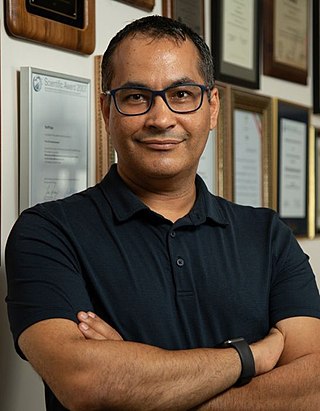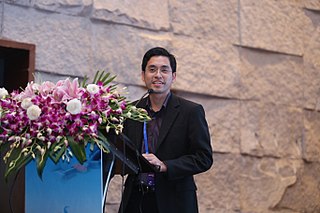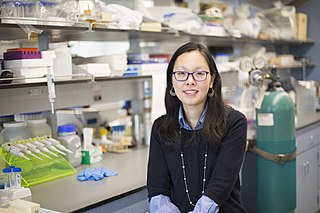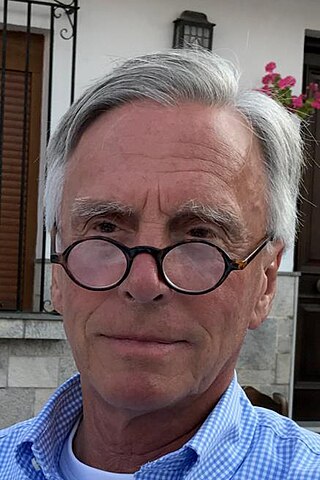Related Research Articles

Nanotechnology is the manipulation of matter with at least one dimension sized from 1 to 100 nanometers (nm). At this scale, commonly known as the nanoscale, surface area and quantum mechanical effects become important in describing properties of matter. This definition of nanotechnology includes all types of research and technologies that deal with these special properties. It is common to see the plural form "nanotechnologies" as well as "nanoscale technologies" to refer to research and applications whose common trait is scale. An earlier understanding of nanotechnology referred to the particular technological goal of precisely manipulating atoms and molecules for fabricating macroscale products, now referred to as molecular nanotechnology.

A hydrogel is a biphasic material, a mixture of porous, permeable solids and at least 10% by weight or volume of interstitial fluid composed completely or mainly by water. In hydrogels the porous permeable solid is a water insoluble three dimensional network of natural or synthetic polymers and a fluid, having absorbed a large amount of water or biological fluids. These properties underpin several applications, especially in the biomedical area. Many hydrogels are synthetic, but some are derived from nature. The term 'hydrogel' was coined in 1894.

Supramolecular chemistry refers to the branch of chemistry concerning chemical systems composed of a discrete number of molecules. The strength of the forces responsible for spatial organization of the system range from weak intermolecular forces, electrostatic charge, or hydrogen bonding to strong covalent bonding, provided that the electronic coupling strength remains small relative to the energy parameters of the component. While traditional chemistry concentrates on the covalent bond, supramolecular chemistry examines the weaker and reversible non-covalent interactions between molecules. These forces include hydrogen bonding, metal coordination, hydrophobic forces, van der Waals forces, pi–pi interactions and electrostatic effects.
Supramolecular polymers are a subset of polymers where the monomeric units are connected by reversible and highly directional secondary interactions–that is, non-covalent bonds. These non-covalent interactions include van der Waals interactions, hydrogen bonding, Coulomb or ionic interactions, π-π stacking, metal coordination, halogen bonding, chalcogen bonding, and host–guest interaction. Their behavior can be described by the theories of polymer physics) in dilute and concentrated solution, as well as in the bulk.

Ali Khademhosseini is an Iranian-born Canadian-American engineer. He is the CEO of the Terasaki Institute, non-profit research organization in Los Angeles, and Omeat Inc., a cultivated-meat startup. Before taking his current CEO roles, he spent one year at Amazon Inc. Prior to that he was the Levi Knight chair and professor at the University of California-Los Angeles where he held a multi-departmental professorship in Bioengineering, Radiology, Chemical, and Biomolecular Engineering as well as the Director of Center for Minimally Invasive Therapeutics (C-MIT). From 2005 to 2017, he was a professor at Harvard Medical School, and the Wyss Institute for Biologically Inspired Engineering.

David Alan Leigh FRS FRSE FRSC is a British chemist, Royal Society Research Professor and, since 2014, the Sir Samuel Hall Chair of Chemistry in the Department of Chemistry at the University of Manchester. He was previously the Forbes Chair of Organic Chemistry at the University of Edinburgh (2001–2012) and Professor of Synthetic Chemistry at the University of Warwick (1998–2001).
Jeremy Keith Morris Sanders is a British chemist and Emeritus Professor in the Department of Chemistry at the University of Cambridge. He is also Editor-in-Chief of Royal Society Open Science. He is known for his contributions to many fields including NMR spectroscopy and supramolecular chemistry. He served as the Pro-Vice-Chancellor for Institutional Affairs at the University of Cambridge, 2011–2015.

Egbert (Bert) Willem Meijer is a Dutch organic chemist, known for his work in the fields of supramolecular chemistry, materials chemistry and polymer chemistry. Meijer, who is distinguished professor of Molecular Sciences at Eindhoven University of Technology (TU/e) and Academy Professor of the Royal Netherlands Academy of Arts and Sciences, is considered one of the founders of the field of supramolecular polymer chemistry. Meijer is a prolific author, sought-after academic lecturer and recipient of multiple awards in the fields of organic and polymer chemistry.

Peptide amphiphiles (PAs) are peptide-based molecules that self-assemble into supramolecular nanostructures including; spherical micelles, twisted ribbons, and high-aspect-ratio nanofibers. A peptide amphiphile typically comprises a hydrophilic peptide sequence attached to a lipid tail, i.e. a hydrophobic alkyl chain with 10 to 16 carbons. Therefore, they can be considered a type of lipopeptide. A special type of PA, is constituted by alternating charged and neutral residues, in a repeated pattern, such as RADA16-I. The PAs were developed in the 1990s and the early 2000s and could be used in various medical areas including: nanocarriers, nanodrugs, and imaging agents. However, perhaps their main potential is in regenerative medicine to culture and deliver cells and growth factors.

Samuel I. Stupp, is a Board of Trustees Professor of Materials Science, Chemistry, and Medicine at Northwestern University in Chicago, IL. He is best known for his work on self-assembling materials and supramolecular chemistry. One of his most notable discoveries is a broad class of peptide amphiphiles that self-assemble into high aspect ratio nanofibers with extensive applications in regenerative medicine. He has also made significant contributions to the fields of supramolecular chemistry, nanotechnology, and organic electronic materials. He has over 500 peer-reviewed publications and was one of the 100 most cited chemists in the 2000–2010 decade.
Ayyappanpillai Ajayaghosh is a research scientist/academician in the domain of interdisciplinary chemistry, and the former Director of the National Institute for Interdisciplinary Science and Technology. He is known for his studies on supramolecular assemblies, organogels, photoresponsive materials, chemosensory and security materials systems and is an elected fellow of all the three major Indian science academies viz. the National Academy of Sciences, India, Indian National Science Academy and the Indian Academy of Sciences as well as The World Academy of Sciences. The Council of Scientific and Industrial Research, the apex agency of the Government of India for scientific research, awarded him the Shanti Swarup Bhatnagar Prize for Science and Technology, one of the highest Indian science awards for his contributions to Chemical Sciences in 2007. He is the first chemist to receive the Infosys Science Prize for physical sciences, awarded by the Infosys Science Foundation. He received the TWAS Prize of The World Academy of Sciences in 2013 and the Goyal prize in 2019.
Martina Heide Stenzel is a Professor in the Department of Chemistry at the University of New South Wales (UNSW). She is also a Royal Australian Chemical Institute (RACI) University Ambassador. She became editor for the Australian Journal of Chemistry in 2008 and has served as Scientific Editor and as of 2021, as Editorial Board Chair of RSC Materials Horizons.

Xian Jun Loh is a Singaporean polymer chemist who works in the inter-disciplinary field of biomaterials. He is the Executive Director of the Institute of Materials Research and Engineering of the Agency for Science, Technology and Research and a professor at the Nanyang Technological University. He is currently the President of the Singapore National Institute of Chemistry.
Vijay Kumar Thakur is an Indian chemist, material scientist and Professor known for his research in the field of polymers, nanotechnology, manufacturing engineering, sustainable chemistry and materials science. He has published over 300 SCI journal articles, 52 Books and two USA patents. He sits on the editorial board of several SCI journals.

Jin Kim Montclare is a Professor of Chemical and Biomolecular Engineering at New York University. She creates novel proteins that can be used in drug delivery, tissue regeneration, and medical treatment. She is a 2019 AAAS Leshner Leadership Fellow and has been inducted into the AIMBE College of Fellows.
Thomas J. Webster is an American biomedical engineer, researcher, and entrepreneur. Throughout his over 25-year academic career, his research group has produced several books and book chapters. He has over 1350 publications and has an H-index of 118.

Roeland J. M. Nolte was a Dutch chemist, known for his work in the fields of organic chemistry, biochemistry, polymer chemistry, and supramolecular chemistry. He was an emeritus Royal Netherlands Academy of Arts and Sciences professor and an emeritus professor of organic chemistry at Radboud University in Nijmegen, The Netherlands. Until his death, he held a special chair, i.e. professor of molecular nanotechnology, at Radboud University. Nolte was considered to be one of the pioneers of the field of supramolecular chemistry, which encompasses the design and synthesis of new chemical structures from low molecular weight compounds and biopolymers using non-covalent interactions. He published many studies on supramolecular assembly and biomimetic catalysts, which find applications in the field of nanomaterials and medicine.
Surita Bhatia is an American chemist who is professor and vice provost of faculty affairs at Stony Brook University. Her work considers the structure of soft materials, including polymeric hydrogels and colloidal glasses. She was elected Fellow of the American Institute of Chemical Engineers, the American Institute for Medical and Biological Engineering and the Society of Rheology in 2020.
Virgil Percec is a Romanian-American chemist and P. Roy Vagelos Chair and Professor of Chemistry at the University of Pennsylvania. Expert in organic, macromolecular and supramolecular chemistry including self-assembly, biological membrane mimics, complex chiral systems, and catalysis. Pioneered the fields of liquid crystals with complex architecture, supramolecular dendrimers, Janus dendrimers and glycodendrimers, organic Frank-Kasper phases and quasicrystals, supramolecular polymers, helical chirality, Ni-catalyzed cross-coupling and multiple living and self-interrupted polymerizations. Most of these concepts were inspired by Nature and biological principles.
Lara Ann Estroff is an American materials scientist who is a professor at Cornell University. Her research considers the study and design of biomaterials.
References
- 1 2 3 "Professor David K. Smith". Department of Chemistry. University of York. Retrieved 7 June 2015.
- 1 2 3 Smith, David K. (September 2011). "From crazy chemists to engaged learners through education". Nature Chemistry. 3 (9): 681–684. Bibcode:2011NatCh...3..681S. doi:10.1038/nchem.1091. ISSN 1755-4330. PMID 21860454.
- 1 2 3 Banham, Andrea; Mizen, Jenifer. "Professor Dave Smith FRSC". 175 Faces of Chemistry: Celebrating Diversity in Science. Royal Society of Chemistry. Archived from the original on 22 October 2020. Retrieved 7 June 2011.
- 1 2 3 "David K. Smith - Group Leader" . Retrieved 7 June 2015.
- ↑ Hirst, Andrew R.; Escuder, Beatriu; Miravet, Juan F.; Smith, David K. (6 October 2008). "High-Tech Applications of Self-Assembling Supramolecular Nanostructured Gel-Phase Materials: From Regenerative Medicine to Electronic Devices". Angewandte Chemie International Edition. 47 (42): 8002–8018. doi:10.1002/anie.200800022. PMID 18825737.
- ↑ Howe, Edward J.; Okesolaa, Babatunde O.; Smith, David K. (31 March 2015). "Self-assembled sorbitol-derived supramolecular hydrogels for the controlled encapsulation and release of active pharmaceutical ingredients" (PDF). Chemical Communications. 51 (35): 7451–7454. doi:10.1039/C5CC01868D. PMID 25824859.
- ↑ "Student helps to discover new pain relief delivery method". Phys.org. 1 April 2015.
- ↑ Smith, David K. (14 October 2014). "iTube, YouTube, WeTube: Social Media Videos in Chemistry Education and Outreach". Journal of Chemical Education. 91 (10): 1594–1599. Bibcode:2014JChEd..91.1594S. doi:10.1021/ed400715s. ISSN 0021-9584.
- ↑ "Highlights - About staff, The University of York". www.york.ac.uk. Retrieved 7 June 2015.
- ↑ "175 Faces of Chemistry - Research Database, The University of York". pure.york.ac.uk. Retrieved 26 February 2021.
- ↑ Smith, David K. (1 April 2014). "'No sexuality please, we're scientists'". Chemistry World. Royal Society of Chemistry. Retrieved 8 June 2015.